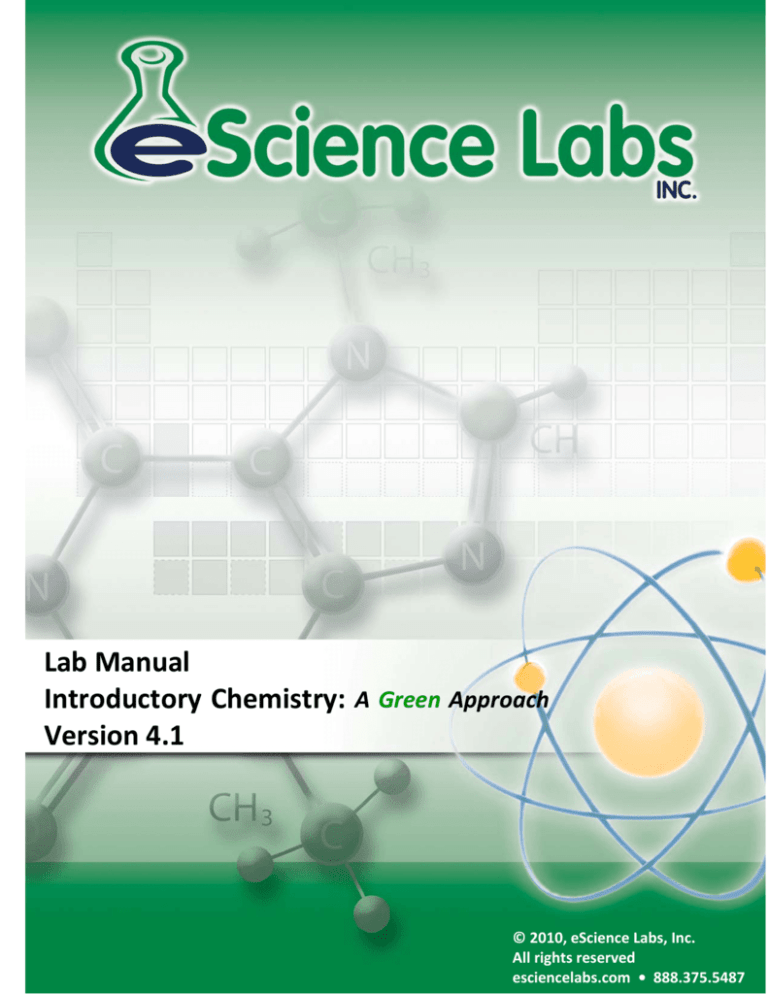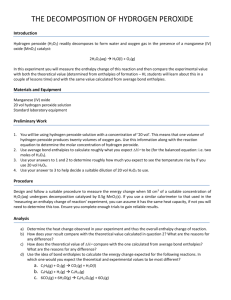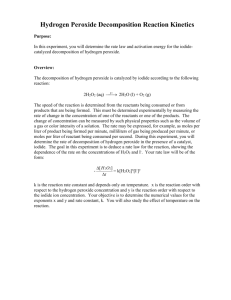
Lab Manual Introductory Chemistry: A Green Approach Version 4.1 © 2010, eScience Labs, Inc. All rights reserved esciencelabs.com • 888.375.5487 Table of Contents Lab 1: Introduc on and Safety Lab 2: The Scien fic Method Lab 3: Data Measurement Lab 4: Electron Configura on Lab 5: Molecular Models Lab 6: Chemical Reac ons Lab 7: The Mole and Avogadro’s Number Lab 8: Ideal Gas Law Lab 9: Acids and Bases 3 Introductory Chemistry Lab 8: Ideal Gas Law Lab 8: Ideal Gas Law Concepts to explore: Use the ideal gas law to determine the percentage of hydrogen peroxide in a commercially available hydrogen peroxide solu on Observe how a catalyst affects a reac on Determine the decomposi on rate of the hydrogen peroxide solu on Introduc on Have you ever opened a container of milk aŌer the
expiraƟon date and found that it had gone bad?
It is very easy to tell if milk has gone bad: it looks, smells, and tastes awful. The putrid odor lets you know a gas is being formed as it decomposes. Many items you purchase are not nearly as easy to tell if they have degraded. Some form a gas that is impossible to detect just by smelling it. Hydrogen peroxide, a common household item that is used to clean minor cuts, is like this. The bo le you buy in the store says it contains 3% hydrogen peroxide, but it will very slowly decompose over me to form water and oxygen gas. Since we breathe oxygen every second, we can’t easily detect this. But we can use the ideal gas law and yeast to find this out! Figure 1: Pressure gauges are found wherever moni‐
toring the pressure of a gas is important—such as this fire ex nguisher above. Simple gauges are commonly used to measure the pressure of air in automobile and bicycle res. The ideal gas law is very valuable when dealing with gases since it establishes a rela onship between temperature, pressure, volume, and amount of a gas. Pressure
In this equa on:
0.6
0.5
PV = nRT
Pressure vs. Volume of a Typical Gas
(Arbitrary Units)
0.4
0.3
0.2
0.1
0
P is the gas pressure in atmospheres 0
V is the volume of the gas in liters 2
4
6
8
10
Volume
n is the number of moles of the gas Figure 2: The rela onship between pressure and vol‐
ume of an ideal gas. With constant T and n, pressure decreases as volume increases. Can you verify this using the equa on to the le ? R is the constant value of 0.0821 L·atm/mol·K T is for the temperature of the gas in Kelvin. Since hydrogen peroxide forms oxygen gas when it decomposes, we can use the ideal gas law to check the percent hydrogen peroxide in a bo le of it purchased at the store. To find this out we need to take a small sample out of the bo le and accelerate its decomposi on through using a catalyst. 2 H2O2
catalyst
2 H2O + O2
79 Lab 8: Ideal Gas Law In this experiment, we will use yeast to accelerate the decomposi on of the hydrogen peroxide into water and O2 gas. Yeast contains the enzyme catalase, which is a catalyst for this reac on. You will add yeast ac vated in warm water to a known amount of hydrogen peroxide and quickly seal off the system so that the O2 gas formed is collected in a graduated cylinder. A er measuring the total volume of gas produced, its temperature, and the atmospheric pressure, the ideal gas law can then be used to calculate how many moles of O2 gas is formed. We can do this by solving the ideal gas law equa on for n. n = PV
RT
Once the number of moles of O2 gas is calculated, the percent of H2O2 present in the solu on can be determined. To do this, you first need to calculate the theore cal number of moles of O2 there would be if the solu on was 100% hydrogen peroxide. This can be found by using the following equa on: Theoretical moles O2 = H2O2 used × H2O2 density × 1 mol H2O2
1 mol O2
× 34.0 g H2O2
2 mol H2O2
For this experiment: mL H2O2 used is the volume of H2O2 you actually use (approximately 5 mL). H2O2 density is 1.02 g/mL 1 mol H2O2 / 34.0 g H2O2 is the reciprocal (inverted frac on). of the molar mass of H2O2 . The molar mass of H2O2 is 34.0 g /mol, so this is equal to 1 mol H2O2 / 34.0 g H2O2. 1 mol O2 / 2 mol H2O2 is used since the decomposi on produces 1 mole O2 from 2 moles of H2O2 . The units in the en re equa on cancel to give moles of O2. The percent hydrogen peroxide can now be found. To do this, divide (n), the actual number of moles you calculated, by the theore cal moles of O2 there would be if the hydrogen peroxide were 100%. This number is then mul plied by 100%. Figure 3: Carbonated beverages contain dissolved CO2 at high pressure. When the container is opened, this pressure can create a powerful burst, such as with this sparkling wine bo le, or when your soda “explodes.” % H2 O2 = Actual moles O2 (n)
100
Theoretical moles O 2
This value can now be compared to the 3% hydrogen peroxide shown on the label to see if any decomposi on has occurred. 80 Lab 8: Ideal Gas Law Pre‐Lab Ques ons 1. What is it in yeast that aids in the decomposi on of hydrogen peroxide? 2. List the ideal gas law and define each term with units. 3. How many moles of O2 were produced in a decomposi on reac on of H2O2 if the barometric pressure was 0.980 atm, the temperature was 298 K and the volume of O2 gas collected was 0.0500 L? 4. If you decomposed 10.00 mL of 100% H2O2, how many moles of O2 could you theore cally obtain? 81 Lab 8: Ideal Gas Law Experiment: Finding Percent H2O2 with Yeast Materials Safety Equipment: Safety goggles, gloves Yeast 10 mL Hydrogen peroxide 10 and 100 mL Graduated cylinders Erlenmeyer flask Stopper with hole Rigid plas c tubing (3 in.) *You must provide Rubber band Flexible tubing (18 in.) 2 Droppers (pipe es) 250 mL Beaker S r rod 600 mL Beaker Thermometer Stopwatch Warm water* Ring stand* Large ring* Dis lled water* *Op onal Materials (not provided) Graduated cylinder Collected gas Rigid tubing Flexible tubing 600 mL Beaker Stopper Ring Stand Rubber Band Erlenmeyer flask Procedure Figure 3: Gas Collec on Apparatus (not to exact scale) 1. Prepare the materials for the apparatus as shown in Figure 1. Insert the smaller rigid tubing into one end of the larger, flexible tubing. Insert the free end of the rigid tubing securely into the rubber stopper hole. 2. Bend the free end of the flexible tubing into a U shape, and use a rubber band to hold this shape in place. This will allow you to more easily insert this end of the flexible tubing into the inverted graduated cylinder. Make sure the tubing is not pinched and that gas can flow freely through it. 2. Fill the 600 mL beaker with 400 mL dis lled water. 3. Fill the 100 mL graduated cylinder with dis lled water slightly over the 100 mL mark. 82 Lab 8: Ideal Gas Law 4. Take the temperature of the water in the 600 mL beaker, and record it in the Data sec on. Also, determine the barometric pressure in the room, and record it in the Data sec on. HINT: The pressure in your region may be found online—if necessary, convert this value to mm Hg. 5. Mix 100 mL of warm water (45°C) and 1 packet of baker’s yeast in a 250 mL beaker. This will ac vate the yeast from the dormant (dry) state. Be sure to mix well with a s r rod un l the yeast is completely dissolved. 6. Use a 10 mL graduated cylinder and pipe e to measure out 5.00 mL of hydrogen peroxide. Pour this hydrogen peroxide into the Erlenmeyer flask, and place the stopper with stopper tube over the top. 7. Clean the 10 mL graduated cylinder by rinsing it at least three mes with dis lled water. Dispose of the rinse down the drain. 8. Cover the opening of the graduated cylinder with two or three fingers and quickly turn it upside down into the 600 mL beaker already containing 400 mL of water. DO NOT remove your fingers from the opening un l the graduated cylinder is fully submerged under the water. If the amount of trapped air exceeds 10 mL, refill the cylinder and try again. 9. Insert the U shaped side of the flexible tubing into the beaker, and carefully snake it into the submerged opening of the graduated cylinder. You want as li le air as possible to be in the graduated cylinder. 10. Secure the graduated cylinder to the ring stand by sliding a ring under the submerged cylinder, then a aching the ring to the stand. OPTIONAL PROCEDURE: If your kit does not include a ring stand, you will hold the graduated cylinder in place while gas is collected. Make sure to keep the open end of the cylinder completely submerged to prevent addi onal gas from entering. Rest the graduated cylinder against the side of the beaker during experimental setup. 11. With the cylinder ver cal, record the volume of air inside (the line at which the water reaches in the cylinder) in the Data sec on in Table 1. 12. Using the pipe e, measure out 5.00 mL of yeast solu on into the rinsed 10 mL graduated cylinder. NOTE: Do not immediately pour the yeast solu on into the Erlenmeyer flask. 13. Prepare to place the stopper (s ll connected to the hose) on the Erlenmeyer flask. Reset the stopwatch. 14. Quickly pour the 5.0 mL of yeast solu on into the Erlenmeyer flask. Immediately place the stopper securely in the opening of the Erlenmeyer flask by twis ng it down into the flask gently. 15. Start ming the reac on with the stopwatch. 16. Swirl the Erlenmeyer flask to mix the two solu ons together. 17. You will begin to see bubbles coming up into the 100 mL graduated cylinder. HINT: If gas bubbles are not immediately visible, make sure the stopper is on ght enough and the tubing is not leaking. You will need to start over a er correc ng any problems. 18. Con nue to swirl the Erlenmeyer flask and let the reac on run un l no more bubbles form to assure the reac on has gone to comple on. This should take approximately 6-10 minutes. HINT: Catalase works best around the temperature of the human body. You can speed the reac on up by warming the Erlenmeyer flask with your hands. 19. Record the me when the reac on is finished in Table 2 of the Data sec on, along with the final volume of air in Table 1. Remember to read it at eye-level and measure from the bo om of the meniscus. 20. Pour all other liquids down the drain and clean the labware. 83 Lab 8: Ideal Gas Law Data Water temperature: ⁰C Barometric Pressure: mm Hg Table 1: Volume data Ini al volume of air (mL) Final volume of air a er reac‐
on (mL) Volume of O2 collected (Final volume ‐ ini al volume) Table 2: Reac on me data Time reac on started Time reac on ended Reac on me (s) Calcula ons The goal is to find the percentage of hydrogen peroxide in the solu on! This can be found by working through the following steps. 1. Convert the temperature of the water from ⁰C to Kelvin (K). Use the equa on K = ⁰C + 273. This will be your value for absolute T or the temperature in Kelvin. T = ⁰C + 273 = K 2. If necessary, convert the barometric pressure in the room from mm Hg to atmospheres (atm). Divide the measured pressure from the Data sec on by 760 mm Hg. This will give you pressure (P) in atmospheres. P = 84 1 atm mm Hg * = 760 mm Hg atm Lab 8: Ideal Gas Law 3. Convert the volume of oxygen from mL to liters (L). V = 1 L mL * = 1000 mL L 4. Rearrange the ideal gas law to solve for n. 5. You are now ready to solve for the number of moles of O2. Be sure the units cancel so that you end up with only the moles of O2 le . Use the value for the constant R given: R = 0.0821 L·atm/mol·K Actual number of moles of O2 (n) = moles 85 Lab 8: Ideal Gas Law 6. Calculate the theore cal number of moles of O2 there would be if the hydrogen peroxide were 100%, and not an aqueous solu on. 1 mol O2 mol H2O2 Theore cal moles of O2 = H2O2 volume * H2O2 density * * 2 mol H O g H2O2 2 2
To use the above equa on, calculate the following: — H2O2 volume is the volume (mL) of hydrogen peroxide used: Volume = — H2O2 density is known: mol H2O2 — g H2O2 mL H2O2 Density = 1.02 g/mL is the reciprocal of the molar mass of H2O2. First write the molar mass of H2O2 then find the reciprocal. Molar mass of H2 O2 = g H2O2/1 mol H2O2 Molar mass of H2 O2 reciprocal = Now you have all of the informa on needed to solve the equa on for the theore cal moles of O2. All you need to do is fill in the blanks and do the calcula ons. Theore cal moles of O2 = * Theore cal moles of O2 = 86 mol * * Lab 8: Ideal Gas Law 7. Find the percent hydrogen peroxide. % H2O2 = Actual moles O2 * 100% = Theore cal moles O2 % 8. You can also easily determine the reac on rate. To do this, divide the total volume of oxygen collected by the total me of the reac on. Reac on rate = Volume O
2 (mL) = Reac on me (s) mL/sec Post‐Lab Ques ons 1. Was the calculated percentage of hydrogen peroxide close to the same as the percentage on the label? 2. Considering that catalysts are not consumed in a reac on, how do you think increasing the amount of catalyst would affect the reac on rate for the decomposi on of hydrogen peroxide? 87 1500 West Hampden Avenue Suite 5-H Sheridan, CO 80110 303‐741‐0674 ⋅ 888‐ESL‐KITS www.eScienceLabs.com









